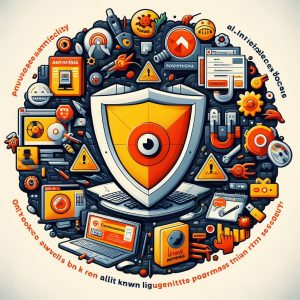I. Introduction
PC Matic antivirus offers a unique approach to malware prevention leveraging whitelisting of known good program files rather than traditional antivirus blacklisting of viruses based on signature databases requiring constant updates. Developed in America by a small team focused on data integrity protections, PC Matic sustains performance efficiencies legacy systems depend upon unlike bloated mainstream endpoint security suites.
As adversaries continually innovate infection mechanisms evading large-vendor reaction speeds relying heavily on signatures updated weeks later, PC Matic stays lightyears ahead via future-facing default-deny security hardening endpoints specifically against weaponized scripts, executables and documents that fail whitelist tests. We detail technical implementation comparisons and customer benefits uniquely offered by PC Matic cementing its niche catering users valuing privacy. Corporate use cases also benefit from PC Matic’s optimizations sustaining trusted computing across aging infrastructure.

II. Whitelisting vs Blacklisting
Fundamentally differentiated from conventional antivirus software, PC Matic relies extensively on application whitelisting rather than solely targeting known virus blacklists:
Proactive Security Premise
Whitelisting actively allows only known good executables like documented Microsoft binaries and typical user software, while blacklisting attempts stopping viruses based on constantly maintained detection signature databases trailing current threats. Hence whitelisting operates proactively securing endpoints by default with locked down policies that blacklist approaches lack until sizable harm manifests infectious payloads through the interim window of exposure minus real-time insight which whitelisting inherently maintains.
Implementation Comparison
Upon PC Matic installation, all applications utilized by the host get catalogued securely into a fluid intelligence inventory of authorized binaries and scripts the system needs for unhindered operations. Attempts to run new unexpected programs then automatically deny by default while analytics determine software classification leveraging clustering algorithms. Once classified legitimate via cloud verification or local permissions, new titles get added to the approved application whitelist locally. Specific software restriction policies allow customizing rigidity levels balancing usability and security as needed per machine ranging from strictly narrowed whitelists to more permissive sets with expanded external change flexibility between reboots. Scope spans beyond traditional antivirus into script and document protections using the same proactive methodology benefiting residual attack surfaces.
Comparatively common antivirus blacklisting centrally updates all global endpoint clients rapidly with the latest detected virus signatures hoping to maintain speed enough catching threats before major outbreaks locally across decentralized installations. But virtually scheduled update lags reaching globally dispersed machines enable infection windows minus real-time local intelligence of unapproved changes whitelisting supplies through constant app state integrity checks on every execution or system modification attempt. Hence whitelisting sustains inside-out security hardening everything by default with outside-in validation rather than depending entirely on external signature update reaction speeds.
Together whitelisting offers inherently secure computing foundations for both legacy and modern systems encountering the same virus strains infiltrating blacklisted antivirus reliant counterparts minus equivalent embedded protections that whitelisting delivers.
III. Features
Core PC Matic capabilities blend application whitelisting together with utilities sustaining system integrity:
Application Whitelisting Engine
Central to PC Matic’s security posture, the application whitelisting engine builds an exclusive inventory of software titles given authorization to run on protected machines. Attempts initiating new unknown executables automatically deny by default to deflect zero-day threats that blacklist dependent antivirus solutions inherently lag defending through reactive signature updates once substantial infections distribute payload variants enough to pattern match mutation strains over time.
Phishing Protection
Augmenting behavior-based application visibility at the endpoint executables layer, PC Matic deploys phishing filters fortifying the adjacent user input web traffic layer to catch malicious links and deceptive authentication portals that host malware payloads escaping whitelist defenses through separate infiltration vectors that blacklist antivirus again lags securing. Hence multilayered inspection sustains security-in-depth strengths across common infection routes.
Performance Tools
As legacy systems endure resource creep from aging hardware unable to shoulder modern bloatware and heavyweight suites, PC Matic embeds several optimizations boosting speed on declined platforms by freeing memory usage, updating drivers and reducing broadband traffic allocation contention. This allows legacy systems to prolong lifespan by years avoiding forced upgrades purely from antivirus-induced platform ending resource starvation rather than actual hardware faults.
Free Offering
Rather uniquely, PC Matic provides full-capability application whitelisting protections entirely free for individual home users instead of just trial versions with an abundance of paid tiers like majority of endpoint antivirus rivals. This makes enterprise-grade security accessible to mainstream consumer groups, charities and house of worship organizations historically lacking adequate IT budgets funding elevated security tools, hence bridging economic access gaps to necessary protections that whitelisting delivers by shifting cost burdens off vulnerable groups least positioned self-fund defense capabilities amid intensifying threats targeting household computers often recycling outdated hardware minus modern security amenities seen in costly proprietary systems.

IV. User Interface and Ease of Use
Unlike dense enterprise suites cramming excessive configuration options overwhelming non-specialists, PC Matic presents a clean visual interface using easily understandable text descriptions translated into multiple languages to reach global users more intuitively through:
Text Driven Menus
Navigational elements utilize clear textual titles describing each component’s security functionality purpose rather than fragmented technical jargon assuming preexisting domain knowledge. For example, sections contain “Whitelist” and “Optimization” delineations with subsections for visitors fluently declared like “Auto Driver Updates” and “Broadband Usage Controls” matching mental models of intended admin roles managing enlisted machines across varied backgrounds appreciating readable guidance to sustain system protections without imposing advanced technical prerequisites.
Click-Centric Navigation
Behind explanatory top-level menu text segments, the underlying dashboard console surfaces simplicity further through graphs, toggles and committed actions requiring mere button clicks to invoke rather than demanding users manually input complex script codes to enable capabilities avoiding common barriers with command line administration. Operations like temporarily allowing unrecognized software that fails whitelist checks get reduced to two selections while returning defaults invoke single keystrokes accelerating reviews for rapid response actions to monitor alerts approximately, then containing impact flexibly.
Together the crisp visual dashboard grants intuitive oversight for monitoring security posture through simplified abilities applied judiciously as threats arise by personnel lacking specialized skills training but still requiring visibility with control customizing protections matching end user needs. This retains accessibility typically missing across competing solutions catering power users and dedicated security engineers predominantly. Democratized defenses lower barriers securing platforms where dedicated ops teams lack practicality or funding.
V. Data Integrity Initiative
Amid growing cybercriminal monetization of stolen user data assets, PC Matic formally commits protecting client information privacy through its Data Integrity Initiative guaranteeing:
Public Commitments
Posted publicly facing voluntary pledges promise zero access to gathered customer usage data by any government entities without enforced legal warrants – contrasting most software nowadays transmitting vast amounts of intrinsically personal usage telemetry, often casually permitted for undisclosed commercial usage despite installation notices rarely read or understood by average clients permitting carte blanche upstream data sharing without informed consent or retention control safeguards.
Technical Limitations
Internally PC Matic technically limits its code base from accessing locally gathered client usage statistics analysis algorithms would typically demand for security modelling research purposes by blocking enriched connections with cloud servers – purposefully constraining internal access to restrict opportunities for involuntary data exploitation preventing temptation and liability. Augmented algorithms instead utilize fully synthetic training data. This sustains trustworthiness assurances aligned with public data commitments exceeding typical software privacy promises rarely backed by technical measures actively preventing unintended data utilization at source.
Together these measures cement PC Matic’s reputation as a genuinely consumer aligned endpoint protection vendor anchored by ethical data practices instead routinely monetizing client usage insights like many free competitors bait users with – ultimately betraying them as data products.

VI. Origin of the Software
Domestically engineered solely within the United States adhering to bottoms-up data ownership principles by founders with Navy cybersecurity backgrounds, PC Matic operates distinctly from foreign coded antivirus counterparts:
Foundational History
PC Pitstop launched initially in 1999 intending improving consumers’ frustrating experiences managing complex computers through tools optimizing usability and performance for accessibility eventually giving way to visibility capabilities uncovering wider integrity issues cybercriminals channeled into lucrative attacks – realities the team witnessed through successively providing bootable recovery tools restoring infected systems. Insights from remediation efforts directly shaped PC Matic’s preventative approach stopping modern infections tactics affecting millions presently through profoundly different whitelist security.
Ongoing customer input continues steering software innovations aligning with user trust principles beyond merely corporate interests or ambient monetization of consumer data like offshore competitors building invasive free antivirus suites fundamentally supported through user data resale. Technology accountability therefore anchors PC Matic’s offering.
Foreign Alternative Contrasts
By comparison, the majority of rival foreign based antivirus suites securely transmit mountains of system telemetry and user behavior data back to headquarters with minimally transparent privacy practices and limited domestic controls restricting access by foreign state entities upon routine requests made – possibly introducing blackmail or profiling risks to the detriment of users lacking basic privilege rights universally present domestically as inheritable Constitutional guarantees limiting Government overreach. Technical constraints also hinder enforcement practicality by US teams or auditors against overseas entities once cumulative data gets exported externally through regular product usage.
Hence domestic development and ownership of security software grants inherent advantages ensuring rights protections remain consistently enforced to standards expected by Americans around limitations on power and data access universally designed within national security law frameworks like checks and balances extending into the cyber domain as well. Foreign solutions frequently lack credible visibility into equivalent scripted overseas constraints probably limiting authorities, providing substantial attack surface